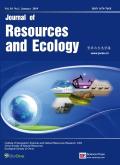The Spatial Distribution and Driving Factors of Carbon Storage in the Grassland Ecosystems of the Northern Tibetan Plateau
Q3 Environmental Science
引用次数: 1
Abstract
Abstract: The investigation of carbon storage in ecosystems and its driving factors is crucial for understanding carbon cycling and achieving the goal of carbon neutrality. The grassland in the Northern Tibetan Plateau is an important grassland ecosystem in China, although the accurate estimation of its carbon stock and our knowledge of its spatial patterns and driving factors in the Northern Tibetan Plateau remain unclear due to insufficient field investigations. In this study, a dataset of 150 measured sample points on the Northern Tibetan Plateau, kriging interpolation and statistical methods were used to estimate the densities of aboveground biomass carbon, belowground root carbon and soil organic carbon at a soil depth of 30 cm, as well as to explore the spatial distribution and the main influencing factors of each carbon pool. The average carbon densities were 0.038 kg C m–2 in aboveground biomass, 0.284 kg C m–2 in belowground biomass, and 7.445 kg C m–2 in the soil. The soil organic carbon accounted for 95.85% of the grassland carbon density. The total carbon storage of the grassland ecosystem in the Northern Tibetan Plateau was about 4.08 Pg C, with a decreasing trend from southeast to northwest. Of the total, the organic carbon stocks of vegetation and soil were 0.58 Pg C (including the aboveground and belowground biomass) and 2.58 Pg C, accounting for 28.29% of the total vegetation carbon and 26.60% of the total soil carbon, respectively, on the Tibetan Plateau, with the remainder stored in the bare land. While the precipitation, temperature and soil texture all affected the ecosystem carbon storage, precipitation played the most significant role and the combination of these three factors explained up to 86.47% of the aboveground carbon density. The aboveground carbon pools in grassland ecosystems of the Northern Tibetan Plateau were most sensitive to climatic factors, while the spatial patterns of belowground and soil carbon storage were more complex. This study provides a spatially accurate assessment of the carbon storage in the grasslands on the Northern Tibetan Plateau.青藏高原北部草原生态系统碳储量空间分布及驱动因素
摘要:研究生态系统中的碳储存及其驱动因素,对于理解碳循环和实现碳中和目标至关重要。青藏高原北部的草原是中国重要的草原生态系统,尽管由于实地调查不足,对其碳储量的准确估计以及我们对其空间格局和驱动因素的了解尚不清楚。本研究以青藏高原北部150个实测样本点为数据集,采用克里格插值和统计方法,估算了30 cm土壤深度下地上生物量碳、地下根碳和土壤有机碳的密度,并探讨了各碳库的空间分布和主要影响因素。地上生物量的平均碳密度为0.038 kg C m–2,地下生物量为0.284 kg C m-2,土壤中为7.445 kg C m-2。土壤有机碳占草地碳密度的95.85%。青藏高原北部草原生态系统的总碳储量约为4.08PgC,呈自东南向西北递减的趋势。其中,青藏高原植被和土壤的有机碳储量分别为0.58 Pg C(包括地上生物量和地下生物量)和2.58 Pg C,分别占植被总碳的28.29%和土壤总碳的26.60%,其余储存在裸地。虽然降水、温度和土壤质地都影响生态系统的碳储量,但降水的作用最为显著,这三个因素的结合解释了高达86.47%的地上碳密度。青藏高原北部草原生态系统地上碳库对气候因素最为敏感,而地下和土壤碳储量的空间格局更为复杂。这项研究为青藏高原北部草原的碳储量提供了一个空间准确的评估。
本文章由计算机程序翻译,如有差异,请以英文原文为准。
求助全文
约1分钟内获得全文
求助全文
来源期刊

Journal of Resources and Ecology
Environmental Science-Ecology
CiteScore
2.40
自引率
0.00%
发文量
107
 求助内容:
求助内容: 应助结果提醒方式:
应助结果提醒方式:


